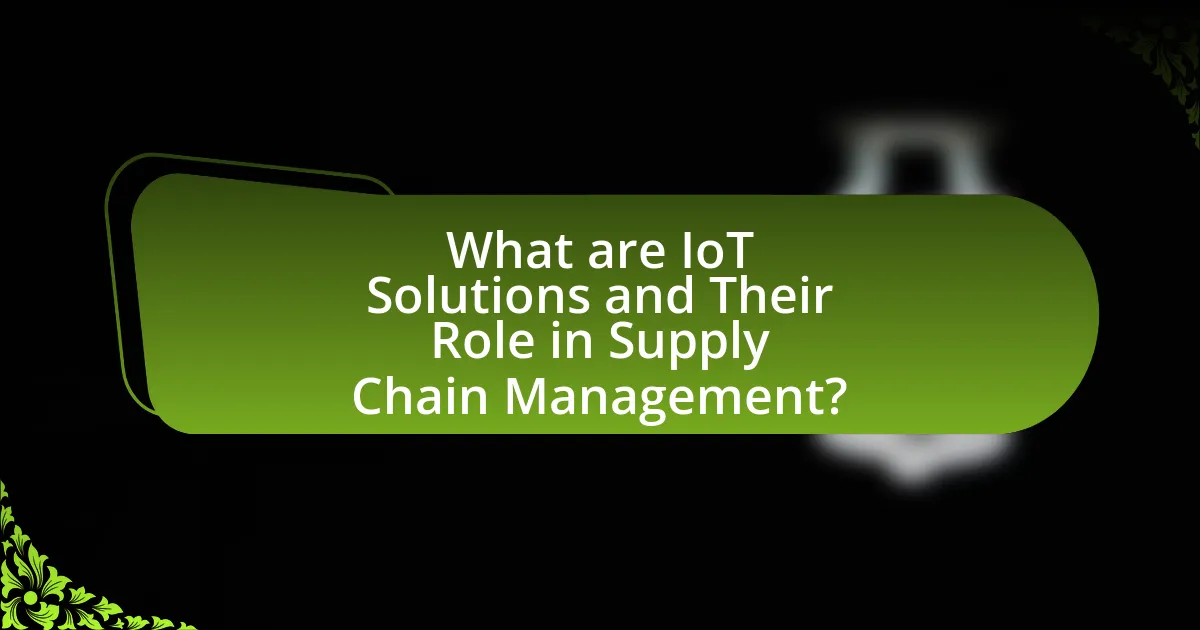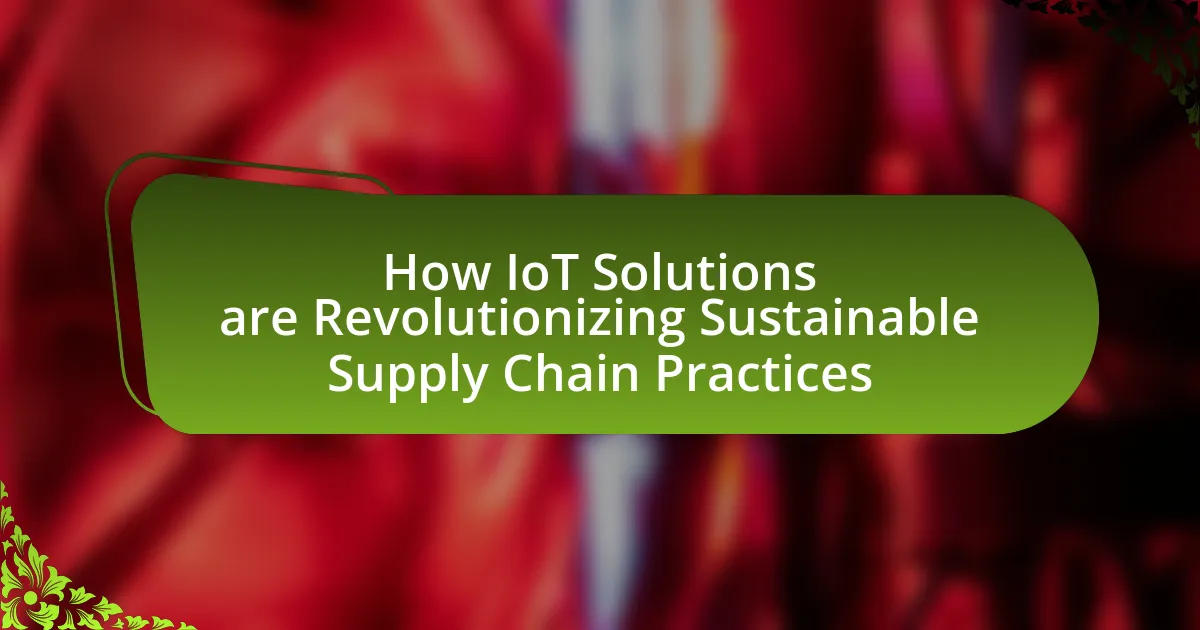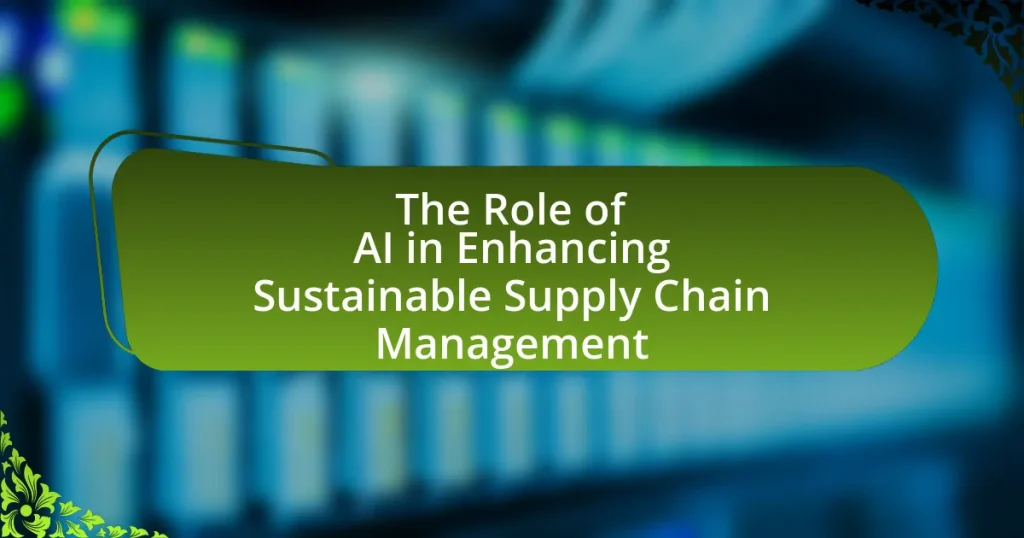IoT solutions, characterized by interconnected devices that collect and analyze data, are transforming sustainable supply chain practices by enhancing operational efficiency and visibility. These technologies provide real-time insights into inventory levels, shipment tracking, and resource management, leading to significant cost reductions and improved sustainability metrics. Key technologies involved include sensors, RFID, GPS, and data analytics, which collectively optimize logistics and minimize waste. The article explores the environmental impacts of traditional supply chains, the financial benefits of sustainable practices, and the challenges businesses face in implementing IoT solutions, while also highlighting best practices for successful integration and collaboration with IoT vendors.

What are IoT Solutions and Their Role in Supply Chain Management?
IoT solutions are interconnected devices and systems that collect, exchange, and analyze data to enhance operational efficiency. In supply chain management, these solutions play a crucial role by providing real-time visibility into inventory levels, tracking shipments, and optimizing logistics. For instance, a study by McKinsey & Company found that IoT can reduce supply chain costs by up to 30% through improved asset utilization and reduced waste. This data-driven approach enables companies to make informed decisions, respond swiftly to market changes, and enhance overall sustainability in their supply chain practices.
How do IoT Solutions enhance visibility in supply chains?
IoT solutions enhance visibility in supply chains by providing real-time data on inventory levels, shipment locations, and equipment status. This continuous flow of information allows businesses to monitor their supply chain processes more effectively, leading to improved decision-making and operational efficiency. For instance, a study by McKinsey & Company found that companies implementing IoT technologies can reduce supply chain costs by up to 15% through better visibility and tracking. Additionally, IoT devices such as sensors and RFID tags enable precise tracking of goods, which minimizes delays and enhances transparency across the supply chain.
What technologies are involved in IoT Solutions for supply chains?
IoT solutions for supply chains involve several key technologies, including sensors, RFID (Radio Frequency Identification), GPS (Global Positioning System), cloud computing, and data analytics. Sensors collect real-time data on inventory levels, temperature, and location, while RFID tags enable automatic tracking of goods throughout the supply chain. GPS technology provides precise location tracking for shipments, enhancing visibility. Cloud computing facilitates the storage and processing of vast amounts of data generated by these devices, allowing for scalable and flexible solutions. Data analytics tools then interpret this data to optimize operations, improve decision-making, and enhance efficiency in supply chain management.
How does real-time data collection impact supply chain efficiency?
Real-time data collection significantly enhances supply chain efficiency by providing immediate insights into inventory levels, demand fluctuations, and operational bottlenecks. This immediacy allows companies to make informed decisions quickly, reducing lead times and minimizing stockouts or overstock situations. For instance, a study by McKinsey & Company found that companies utilizing real-time data analytics can improve their supply chain performance by up to 15%. By leveraging IoT technologies, businesses can track shipments and monitor equipment health in real-time, leading to optimized logistics and reduced operational costs.
Why is sustainability important in supply chain practices?
Sustainability is important in supply chain practices because it enhances efficiency, reduces costs, and minimizes environmental impact. Sustainable supply chains lead to better resource management, which can decrease waste and energy consumption. For instance, a study by the World Economic Forum found that companies implementing sustainable practices can reduce operational costs by up to 20%. Additionally, sustainable supply chains improve brand reputation and customer loyalty, as consumers increasingly prefer environmentally responsible companies. This shift is supported by a Nielsen report indicating that 66% of global consumers are willing to pay more for sustainable brands.
What are the environmental impacts of traditional supply chains?
Traditional supply chains significantly contribute to environmental degradation through high carbon emissions, resource depletion, and waste generation. The transportation of goods across long distances leads to increased greenhouse gas emissions; for instance, logistics accounts for approximately 14% of global CO2 emissions. Additionally, traditional supply chains often rely on non-renewable resources, resulting in habitat destruction and biodiversity loss. The production processes involved generate substantial waste, with the World Bank estimating that global waste generation will increase by 70% by 2050 if current trends continue. These impacts highlight the urgent need for more sustainable practices in supply chain management.
How can sustainable practices benefit businesses financially?
Sustainable practices can benefit businesses financially by reducing operational costs and enhancing brand reputation. Implementing energy-efficient technologies and waste reduction strategies can lead to significant savings; for example, companies that adopt energy-efficient practices can reduce energy costs by up to 30%, according to the U.S. Department of Energy. Additionally, businesses that prioritize sustainability often attract environmentally conscious consumers, which can increase sales and customer loyalty. A Nielsen report indicates that 66% of global consumers are willing to pay more for sustainable brands, demonstrating a direct correlation between sustainability efforts and financial performance.
How are IoT Solutions transforming sustainable supply chain practices?
IoT solutions are transforming sustainable supply chain practices by enabling real-time monitoring and data analytics, which enhance efficiency and reduce waste. For instance, sensors track inventory levels and environmental conditions, allowing companies to optimize resource usage and minimize excess production. According to a report by McKinsey, companies implementing IoT technologies can reduce supply chain costs by up to 30% while improving sustainability metrics. This integration of IoT not only streamlines operations but also supports compliance with environmental regulations, ultimately fostering a more sustainable supply chain.
What specific IoT applications promote sustainability in supply chains?
Specific IoT applications that promote sustainability in supply chains include smart inventory management, predictive maintenance, and real-time tracking systems. Smart inventory management utilizes IoT sensors to monitor stock levels, reducing waste and ensuring optimal resource use. Predictive maintenance employs IoT devices to analyze equipment performance, allowing for timely repairs and minimizing downtime, which conserves resources. Real-time tracking systems provide visibility into the supply chain, enabling companies to optimize routes and reduce fuel consumption, thereby lowering carbon emissions. These applications collectively enhance efficiency and sustainability in supply chain operations.
How do IoT Solutions reduce waste and improve resource management?
IoT solutions reduce waste and improve resource management by enabling real-time monitoring and data analysis of resource usage. These technologies facilitate precise tracking of inventory levels, energy consumption, and waste generation, allowing organizations to optimize their operations. For instance, a study by McKinsey & Company found that IoT applications in supply chains can lead to a 20-30% reduction in waste through enhanced visibility and predictive analytics. By leveraging sensors and connected devices, businesses can identify inefficiencies, reduce excess inventory, and minimize resource wastage, ultimately leading to more sustainable practices.
What challenges do businesses face when implementing IoT Solutions for sustainability?
Businesses face several challenges when implementing IoT solutions for sustainability, including high initial costs, data security concerns, and integration complexities. High initial costs can deter investment, as companies must allocate significant resources for hardware, software, and infrastructure. Data security concerns arise due to the vast amount of sensitive information collected, making businesses vulnerable to cyberattacks. Integration complexities occur when attempting to connect IoT devices with existing systems, which can lead to operational disruptions. According to a report by McKinsey, 70% of companies cite integration as a major barrier to IoT adoption, highlighting the widespread nature of this challenge.
How can companies overcome data security concerns with IoT?
Companies can overcome data security concerns with IoT by implementing robust encryption protocols and regular software updates. Encryption protects data transmitted between devices, making it unreadable to unauthorized users, while regular updates patch vulnerabilities that could be exploited by cyber threats. According to a report by McKinsey, organizations that adopt comprehensive security measures can reduce the risk of data breaches by up to 80%. Additionally, employing network segmentation limits access to sensitive data, further enhancing security.
What are the costs associated with adopting IoT Solutions in supply chains?
The costs associated with adopting IoT solutions in supply chains include initial investment, operational expenses, and maintenance costs. Initial investment encompasses expenses for hardware, software, and infrastructure, which can range from thousands to millions of dollars depending on the scale of implementation. Operational expenses involve costs related to data management, connectivity, and energy consumption, which can increase as the number of connected devices grows. Maintenance costs include ongoing support, updates, and potential system upgrades, which are essential for ensuring the reliability and security of IoT systems. According to a report by McKinsey, companies can expect to invest between 1% to 5% of their total revenue on IoT solutions, highlighting the significant financial commitment required for successful integration into supply chains.
How can businesses measure the impact of IoT Solutions on sustainability?
Businesses can measure the impact of IoT solutions on sustainability by analyzing key performance indicators (KPIs) such as energy consumption, waste reduction, and resource efficiency. For instance, IoT devices can provide real-time data on energy usage in manufacturing processes, enabling companies to identify inefficiencies and implement energy-saving measures. A study by McKinsey & Company found that IoT applications in supply chains can reduce energy consumption by up to 20%, demonstrating a direct correlation between IoT implementation and sustainability improvements. Additionally, businesses can track reductions in carbon emissions and improvements in recycling rates through IoT-enabled monitoring systems, providing concrete evidence of their sustainability efforts.
What key performance indicators should be tracked?
Key performance indicators (KPIs) that should be tracked in the context of IoT solutions for sustainable supply chain practices include carbon footprint, inventory turnover, order accuracy, and supply chain cycle time. Carbon footprint measures the total greenhouse gas emissions associated with supply chain activities, providing insight into environmental impact. Inventory turnover indicates how efficiently inventory is managed, reflecting responsiveness to demand and waste reduction. Order accuracy tracks the percentage of orders delivered correctly, which is crucial for customer satisfaction and operational efficiency. Supply chain cycle time measures the total time taken from order placement to delivery, highlighting areas for improvement in speed and efficiency. These KPIs are essential for assessing the effectiveness of IoT implementations in promoting sustainability within supply chains.
How can companies assess the return on investment from IoT Solutions?
Companies can assess the return on investment (ROI) from IoT solutions by analyzing key performance indicators (KPIs) such as cost savings, efficiency improvements, and revenue growth directly linked to IoT implementations. For instance, a study by McKinsey found that companies leveraging IoT can achieve up to a 30% reduction in operational costs and a 20% increase in productivity. By quantifying these metrics, organizations can create a clear financial picture of the benefits derived from IoT technologies, enabling them to make informed decisions about future investments.
What best practices should companies follow when integrating IoT Solutions into their supply chains?
Companies should prioritize data security, interoperability, and scalability when integrating IoT solutions into their supply chains. Ensuring robust data security protects sensitive information from breaches, which is critical as IoT devices often collect vast amounts of data. Interoperability allows different IoT devices and systems to communicate effectively, enhancing operational efficiency. Scalability ensures that the IoT infrastructure can grow with the business, accommodating future needs without significant overhauls. According to a report by McKinsey, companies that implement these best practices can achieve up to a 30% reduction in operational costs and a 20% increase in supply chain efficiency.
How can organizations ensure successful collaboration with IoT vendors?
Organizations can ensure successful collaboration with IoT vendors by establishing clear communication channels and defining mutual goals. Effective communication fosters transparency and alignment on project objectives, which is crucial for integrating IoT solutions into supply chain practices. Additionally, organizations should conduct thorough vendor assessments to evaluate technical capabilities and compatibility with existing systems, ensuring that the chosen vendor can meet specific operational needs. Research indicates that companies with well-defined collaboration frameworks experience a 30% increase in project success rates, highlighting the importance of structured partnerships in achieving desired outcomes.
What steps can be taken to train staff on new IoT technologies?
To train staff on new IoT technologies, organizations should implement a structured training program that includes hands-on workshops, online courses, and continuous learning opportunities. This approach allows employees to gain practical experience and theoretical knowledge, which is essential for effectively utilizing IoT solutions in sustainable supply chain practices. Research indicates that companies that invest in comprehensive training programs see a 20% increase in employee productivity and a 30% reduction in operational errors, demonstrating the effectiveness of such training initiatives.



